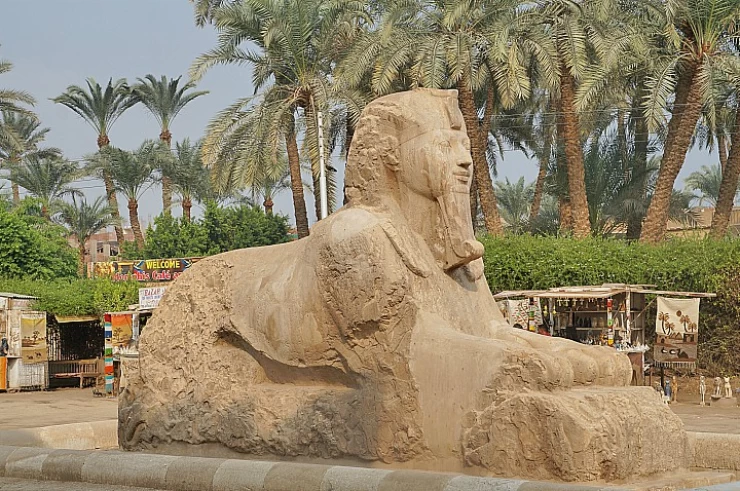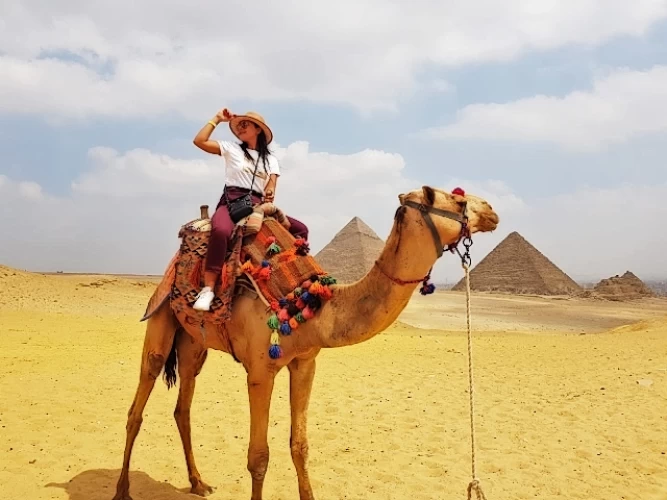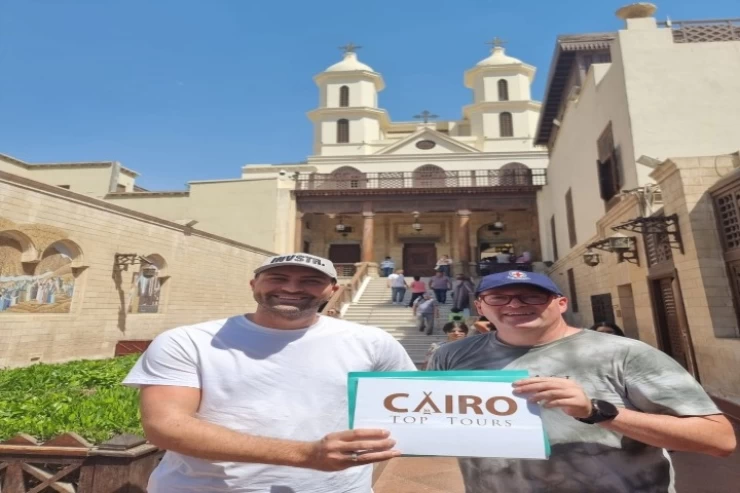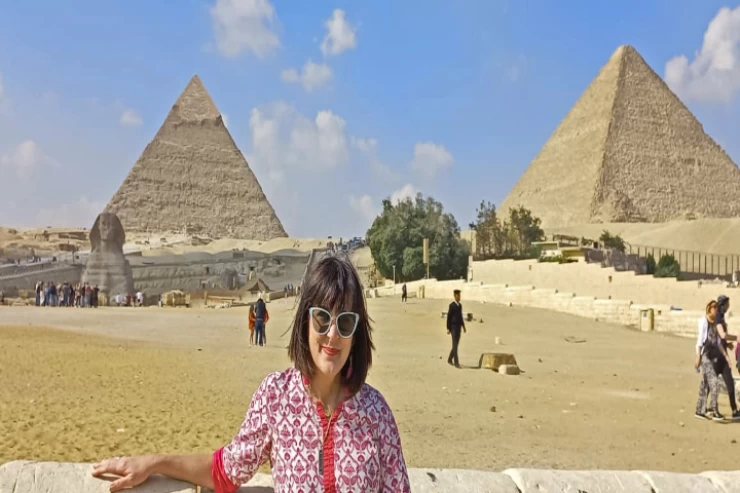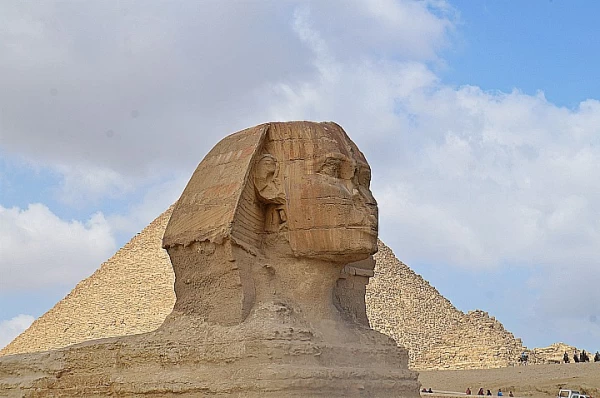
Sphinx antico Egitto
Sphinx antico Egitto
La Sfinge è uno dei monumenti storici più famosi nella Repubblica Araba d'Egitto e in particolare nella città egiziana di Giza, grazie al suo aspetto unico e alla sua posizione unica vicino alle piramidi di Giza, che è uno dei simboli più importanti dell'antico Civiltà egizia insieme a questa statua storica, e molti indicano la storia e gli archeologi sottolineano che questa grande statua appartiene all'antica civiltà egizia e in particolare al periodo del dominio della Quarta dinastia che governava l'Egitto in quel momento, e alcuni di loro datati la proprietà di questa statua al re Khafra, uno degli antichi re e governanti egizi.
Questa statua della Sfinge è stata scolpita da un unico blocco di pietra, e questa statua è stata formata con un corpo di leone che rappresenta la forza e la testa di una persona che rappresenta l'intelligenza, che gli ha fatto combinare in un genio unico la forza dell'animale con l'intelligenza dell'uomo rappresentato dalla persona del re regnante d'Egitto come figlio del dio Amon Ra, il Signore del Santo Sole.
Alla statua manca il mento, alcune delle quali sono esposte in sfingi al Museo Egizio di Tahrir Square e al British Museum di Londra, e di fronte ad "Abu Hool" ci sono i resti architettonici di un tempio non finito di grandi dimensioni, e questo tempio risale indietro all'era della IV dinastia.
Nell'era del Nuovo Regno, le statue della "Sfinge" con la testa di un ariete o la testa di un falco si diffusero in prima linea nei templi di Luxor e Karnak. E il re Tuthmosis il quarto, dall'età della diciottesima famiglia nello stato moderno, ha allestito un dipinto da sogno tra i due artigli della statua di Abul-Hall a Giza per sostenere la sua ascesa al trono d'Egitto basato sul suo fabbricazione di una storia che confermasse il sostegno del dio a lui per diventare il prossimo sovrano dell'Egitto in quel momento.
Le campagne guidate da Tuthmosis III in Asia ebbero un grande impatto sullo sviluppo delle statue della Sfinge, per la prima volta apparve la Sfinge vittoriosa che calpestò i suoi nemici sotto i suoi piedi, e solo in questa era la Sfinge abbandonò la sua testa umana e sostituirla con la testa del leggendario cane o con le teste di ariete come quelle all'ingresso del tempio di Karnak.
In epoca greco-romana, apparvero 3 diversi tipi di "forme" delle statue della Sfinge, una delle quali è il puro stile egizio, che è uno stile che non è cambiato dalla forma tradizionale della Sfinge, che era conosciuta in volte precedenti. Quanto al terzo, era un misto tra egiziani e greci. Il copricapo della statua è egiziano puro, mentre gli artigli e le gambe incrociate sono greci.
Le Sfingi non sono state utilizzate solo attraverso i secoli in Egitto, ma anche al di fuori dell'Egitto, per due ragioni. Il primo sono le relazioni commerciali e il secondo è l'estensione dello stato egiziano al suo controllo e influenza che ha raggiunto il sud delle montagne anatoliche. Quindi, una statua d'avorio di Nimrod apparve in Assiria.
Il nostro team vi aiuterà a viaggiare in Egitto e sperimentare il tempo soleggiato del nostro bel paese durante la Pasqua 2024, grazie alla loro vasta conoscenza del turismo egiziano. Puoi personalizzare il tuo pacchetto selezionando uno dei nostri pacchetti di viaggio in Egitto o sfruttare al massimo il tuo tempo in una breve visita, imparando di più sulla storia egiziana e le sue affascinanti storie e vivendola attraverso tour privati al Cairo. Partecipa a uno dei nostri tour economici in Egitto attraverso il deserto del Sahara, come i tour di Siwa dal Cairo, per esempio, o preferibilmente i tour nel Deserto Bianco d'Egitto. Scoprite i nostri tour di un giorno ad Assuan, fate una gita di un giorno da Assuan ad Abu Simbel, o viaggiate via terra e godetevi i nostri tour di un giorno a Luxor per vedere gli incredibili templi di Karnak, il Tempio di Luxor, il Tempio di Hatshepsut, e vedete le meravigliose tombe splendidamente dipinte nella Valle dei Re, questo è il luogo dove i re e i governanti del nuovo regno riposano in pace e imparate i loro riti di mummificazione e sepoltura.
The Sphinx is one of the most famous historical monuments in the Arab Republic of Egypt and specifically in the Egyptian city of Giza, due to its unique appearance and its unique location near the pyramids of Giza, which is one of the most important symbols of ancient Egyptian civilization along with this historical statue, and many indicate History and archeologists point out that this great statue belongs to the ancient Egyptian civilization and specifically to the period of the rule of the Fourth Dynasty that ruled Egypt at that time, and some of them dated the ownership of this statue to King Khafra, one of the ancient Egyptian kings and rulers.
The Sphinx primarily guards the temples where the gods are worshipped. These gods had omniscient powers that enabled them to control the fate of humans and cause phenomena to occur in the world.
This statue of the Sphinx was carved from a single block of stone, and this statue was formed with a lion's body representing strength and the head of a person representing intelligence, which made him combine in a unique genius the strength of the animal with the intelligence of man represented by the person of the reigning king of Egypt as the son of the god Amun Ra, the Lord of the Holy Sun.
The dating of the Sphinx remains a subject of debate; some Egyptologists assume it dates from the reign of Chephren, while other Egyptologists attribute it to the reign of Cheops' son and Chephren's brother, King Djedefre.
In 1936, the Egyptian Egyptologist Selim Hassan discovered the Temple of the Sphinx. It is an unfinished temple, erected to the east of the Sphinx, and is rectangular in plan... The eastern facade of the temple is pierced by two entrances giving access to an open-air courtyard decorated with 24 pillars.
The temple has two sanctuaries, one to the east and the other to the west. Their orientation suggests that one represents the rising sun and the other the setting sun...Note that the 24 pillars of the courtyard may represent the 12 hours of the day and the 12 hours of the night.
The most common version that the cause of the statue's broken nose was the French commander Napoleon Bonaparte during his leadership of the French campaign on Egypt, but there is another older historical account by the historian Taqi al-Din al-Maqrizi, in the fifteenth century AD, which refuted this account.
It was a fanatical Fatimist, who believed that monuments are idols that must be destroyed, as this sheikh carried out a campaign to remove vices and depictions, especially the Sphinx, and he continued to strive to destroy it, until he was satisfied with mutilating its mouth and nose, and the statue remained in this state to this day.







